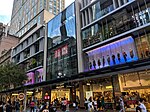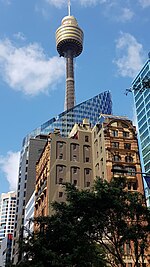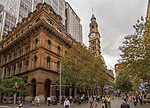The General Post Office (abbreviation GPO, commonly known as the Sydney GPO) is a heritage-listed landmark building located in Martin Place, Sydney, New South Wales, Australia. The original building was constructed in two stages beginning in 1866 and was designed under the guidance of Colonial Architect James Barnet. Composed primarily of local Sydney sandstone, mined in Pyrmont, the primary load-bearing northern façade has been described as "the finest example of the Victorian Italian Renaissance Style in NSW" and stretches 114 metres (374 ft) along Martin Place, making it one of the largest sandstone buildings in Sydney.Throughout its twenty five year construction process, the GPO was marred by two major controversies, the first of which related to the selection of bells for the campanile clock and the second, more significantly, to the commission of Italian immigrant sculptor Tommaso Sani's "realistic" depictions of people for the carvings along the Pitt Street arcade. Sculpture was an important consideration for architects in the second half of the 19th century. From the very outset Barnet set in motion an ambitious comprehensive carefully conceived sculpture programme, beginning with George Street which was later continued on Martin Place and the Pitt Street facades, evolving with adjustments of treatment as interpreted by the sculptors involved, but with only on one singular occasion departing markedly in any large measure from the original template of carved keystones and alto relief spandrel infill sculpture. The classical mode begun on George Street was largely followed. An exception is the main entrance on Martin Place where the Italian sculptor Giovanni Fontana in Sicilian, working from his studio in Chelsea, was commissioned to complete the figure of Queen Victoria, robed as Queen and Empress with her crown and sceptre, at her feet, two symbolic figures of Britannia and New South Wales in Sicilian marble. Beneath the two stretched figures, the English sculptor, Thomas Vallance Wran, created the royal coat of arms dated 1883 and the line of twenty-four classical in situ heads on the colonnade arches, representing either a continent, country or state, namely: Europe, Asia, Russia, Italy, Germany, United States of America, Canada, India, Belgium, France, Austria, Polynesia, on the Pitt Street side, and on the right, George Street side, Australia, New Zealand, Tasmania, Queensland, Ireland, England, Scotland, Victoria, South Australia, Western Australia, Africa and South America. The new electric telegraph technology connected Australia with the world in a matter of days ending the tyranny of distance which, since colonial times, had burdened commerce and trade relations. The heads symbolize this great triumph over time and distance, the General Post Office itself, a celebratory nineteenth-century version of High-tech dressed in a Renaissance garment. The Wran sculptures continued around into Pitt Street where he carved a second coat of arms complementing the arms in George Street and series of keystone heads of the four seasons as symbols of the Post Office as a self-perpetuating never resting service to the people of NSW.
Mixed with the Wran sculpture were a series of controversial and hugely misunderstood alto relief spandrel sculptures by Tommaso Sani reliefs depicting everyday scenes from Sydney life. In reality the Sani reliefs were late less sophisticated examples of the 1840s Italian realist style known as Verismo whose leading exponent was Vicenzo Vela (1820-1891), but drew the ire and derision of an uniformed elite one of whose members was, Frederick Darley (later, the Chief Justice of NSW) who "denigrated the carvings as caricatures", and such was the controversy surrounding these works that it led to debates on aesthetics and taste within the New South Wales Legislative Assembly between 1883–1890 in which Barnet was himself called upon to justify and defend his decision. The Verismo style was a break in the solemn and pompous academism and Sani was a Macchiaioli follower associated with the Garribaldi Risorgimento. Despite severe criticism and controversy, by the time of its final completion in 1891, the building was hailed as a turning point for the Colony of New South Wales, and historians have since noted the building's significance as a force for driving prosperity and for the Federation of Australia. Its architectural expression and in particular its Pitt Street carvings have since been hailed as "the beginning of art in Australia," as well as its urban significance in the shaping of Sydney's urban grid and the Martin Place precinct.The building served as the headquarters of Australia Post from its completion until 1996 when it was privatised and refurbished. The scaled back day-to-day counter postal services are now located on the George Street frontage and the outlet is known as the Sydney GPO Post Shop. The old General Post Office post boxes and Poste restante services are now located in the Australia Post site in the Hunter Connection, on the corner of George Street and Hunter Street. Despite significant internal alterations and additions, the façade has remained virtually unchanged and is listed both on the Commonwealth Heritage List and the New South Wales State Heritage Register, as recognition of its architectural and social significance to the history of Australia.











